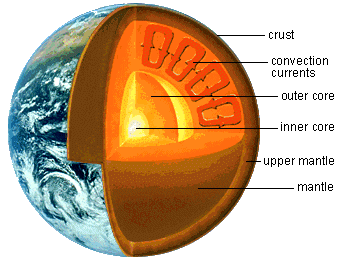 |

About the Earth's Structure
As the earth cooled, it's interior separated into three major concentric zones, which can be identified as the core, the mantle and the crust (refer to the picture below).

The Core
The earth's innermost zone, the core, begins a little less than halfway down the 6400 kilometer (3900 mile) distance from the earth's surface to it's center. The inner core is a solid ball with a diameter of about 2400 kilometers (1400 miles) , made mostly of iron and perhaps some nickel. Although it's temperature may be 4300 °C (7700 °F) or more, the inner core is not liquid because the extreme pressure there prevents melting.
The outer core, which surrounds the inner core, is liquid, with a temperature of 3700-4300 °C (6700-7700 °F). It currently extends between depths of about 2900 and 5200 kilometers (1800 - 3100 miles). Its base is gradually rising, however because as the earth continues to cool, more material solidifies into inner core. The inner and outer core make up about 16% of the earth's volume and 31% of its mass.
The Mantle
The earth's core is surrounded by a thick, solid zone called the mantle which begins at a depth of 10-65 kilometers (6 - 40 miles). This zone makes up 82% of the earth's volume and 68% of its mass. Iron is the major constituent of the mantle, but oxygen, silicon, and magnesium are also present in large proportions.
The outermost part of the mantle is rigid and strong. Apparently, though, temperature and pressure conditions at a depth of 100 - 200 kilometers (60 - 120 miles) are such that rock partially melts into a viscous liquid.
The Crust
The crust is the thinnest of the earth's zones, constituting only 2% of the planets volume and 1% of it's mass. The crust consists of a comparatively low density, brittle material varying from 10 to 65 kilometers (6 to 40 miles). This consists predominately of silica and aluminium; hence it is called 'sial'. Extending under the ocean floors and below the sial is a basaltic layer known a 'sima', consisting mainly of silica and magnesium. There are two categories of crust - oceanic crust and continental crust - differ in composition, density, and thickness, with the continents rising above the ocean basins.
Oceanic crust, which covers about 71% of the earth's surface, is up to 10 kilometers (6 miles) thick. This relatively dense, low-lying crust provides a place for a large part of the earth's water to collect as oceans.
Continental crust is higher and thicker than oceanic crust. It is as much as 65 kilometers (40 miles) thick under mountain ranges and averages 35 kilometers (22 miles) thick. Continental crust has a lower density than oceanic crust so that it "floats" much higher on the denser mantle.


© Copyright 2002, 2003 Seelendran Naidoo
All rights reserved.
|


